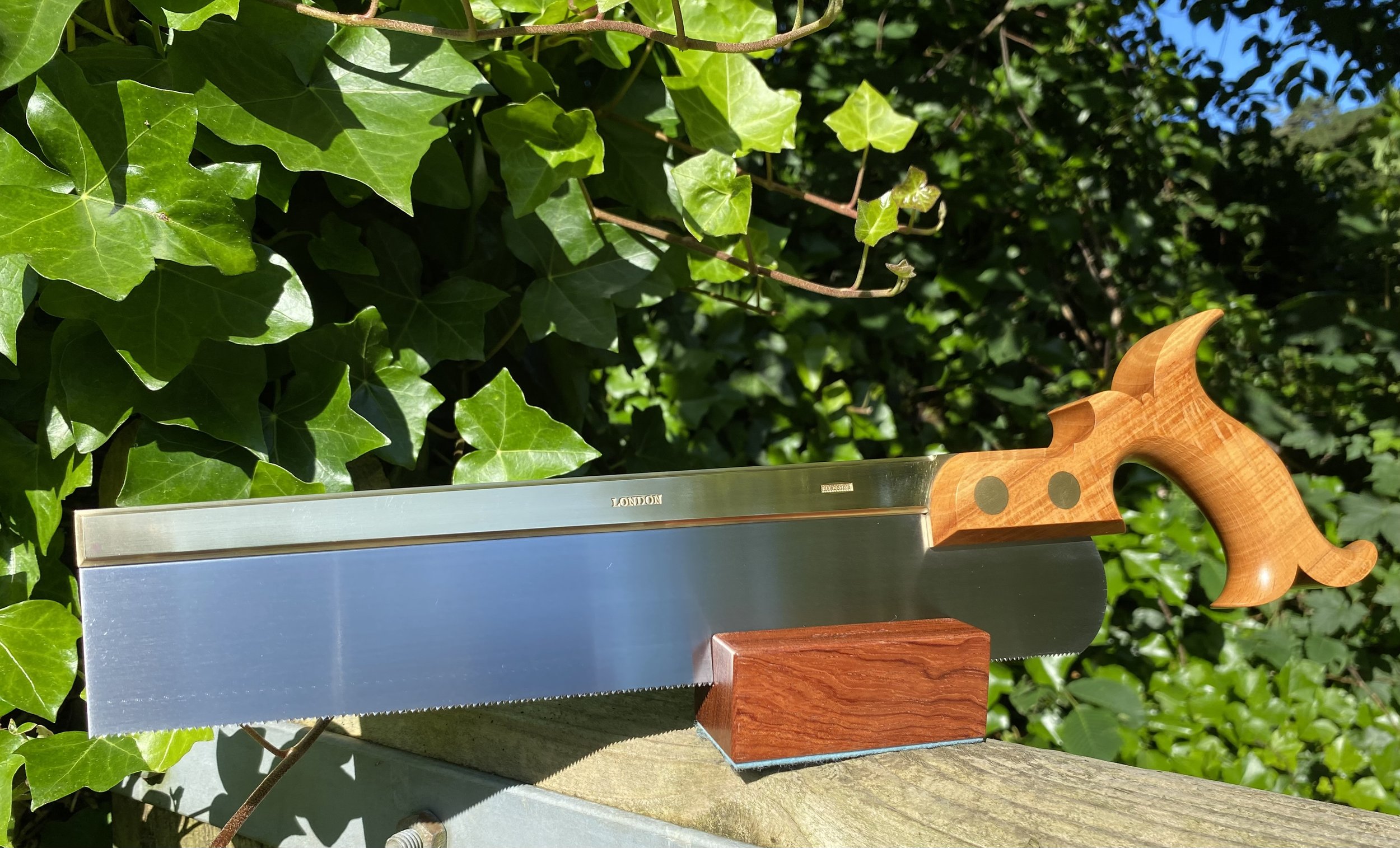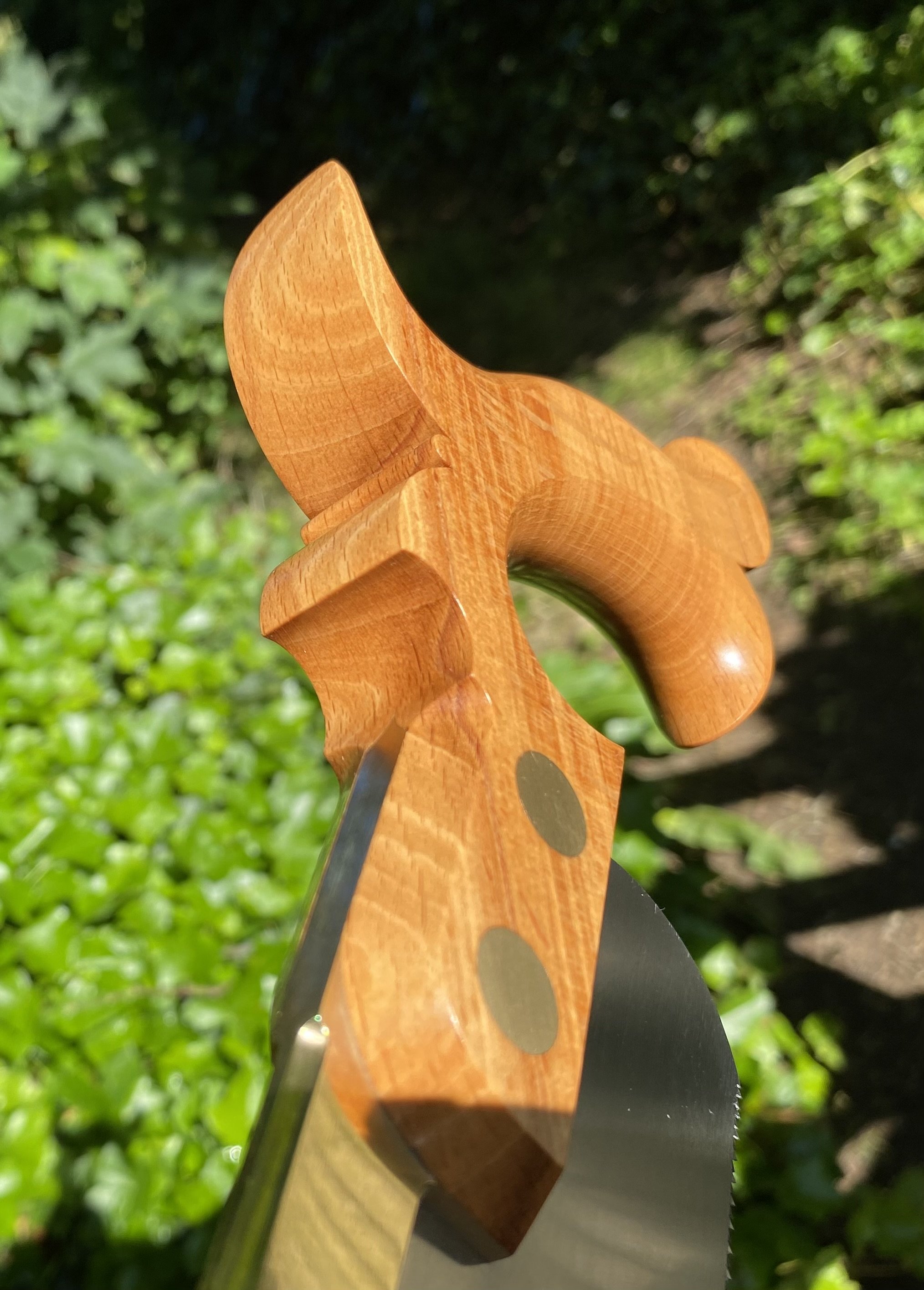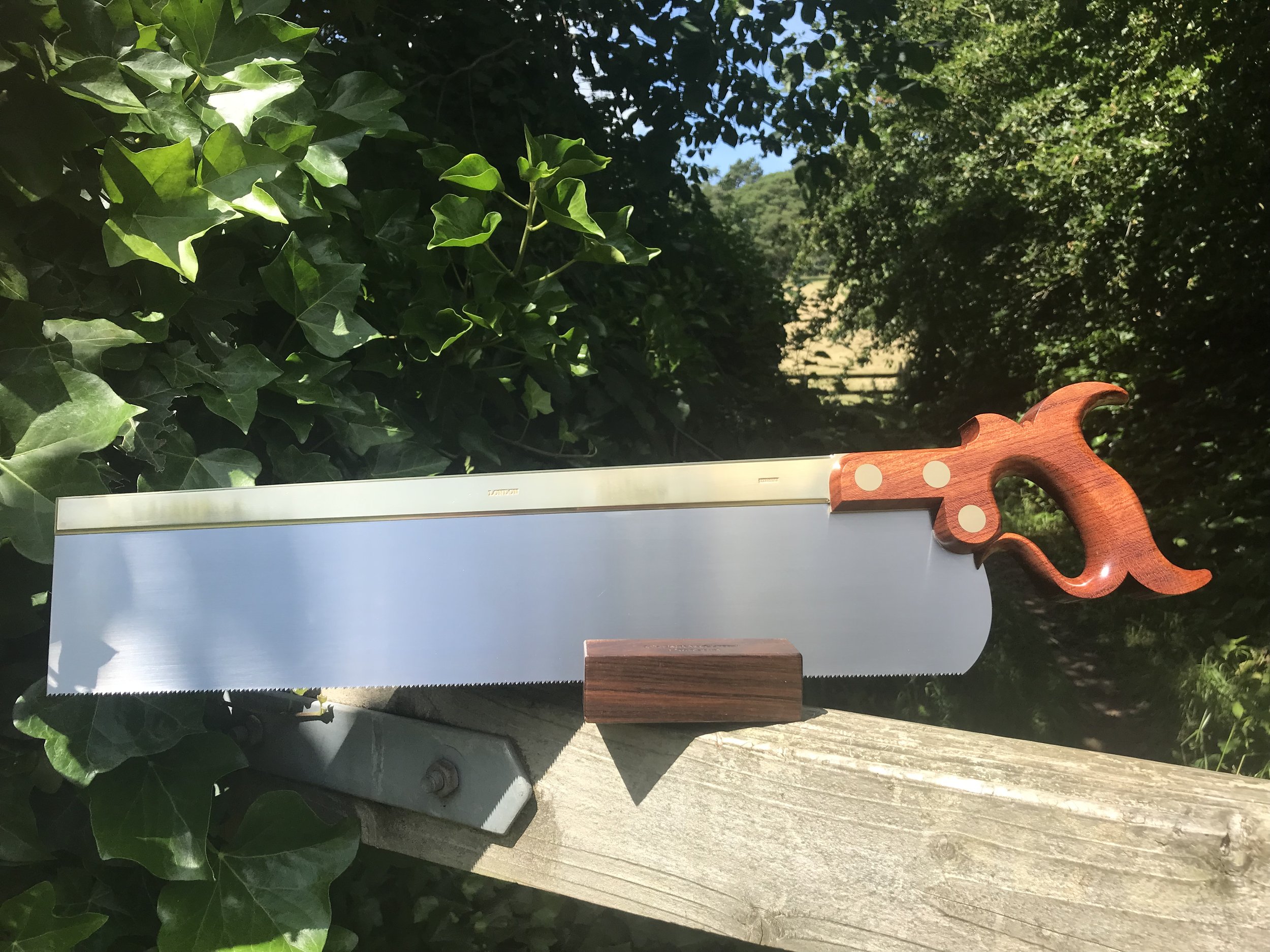BRONTE SAWS
The Brontë Range
Drawing inspiration from the best saw makers and artisans of the 18th Century, authoresses of the 19th Century and by adding his own unique 21st Century design features, the quality of craftsmanship that Shane has produced in this range would leave even the Brontë sisters lost for words! Created solely for the end user and despite the complexities of their creation, Shane is motivated by the notion that these saws could never be made by a machine, and that the owner will take pride in using a cosmetically sound and accurate tool that is truly handmade. The Brontë Range is made up of three saw types, the dovetail, carcass and tenon, each giving a nod to one of the three most famous Yorkshire literary sisters – The Brontë’s.
A New Design Concept
The purpose of developing this range was to create a saw that has a highly tensioned rigid blade that will never move over the lifetime of the saw. A saw which is perfectly balanced, graceful and striking. Shane, employs the same mindset in his work as his 18th Century contemporaries, always developing and changing things. Let’s not forget that the 18th Century saw makers were the first to introduce a brass back to a saw, since then no-one else other than Shane has attempted to change the construction of this tool. Designed for making a longer stroke, this range of saws allows for the ganging up of joints and both quicker and accurate work practices. With more teeth doing less work, these saws also do not require sharpening quite as frequently. What is more there is something rather ‘cheeky’ about this unique design! – Shane, has created a ‘half cheek’ allowing the user to utilise their saw blade to full capacity.
Design Advantages
Traditional Saw Design
Traditional saw designs / construction for example folded back saws rely on a vice like tension from the brass back nipping the saw plate. This tension is achieved by tapping the toe and the heel of the saw back thus allowing it to further grab onto the toe and heel of the plate but not moving in the centre. The disadvantages of this construction are:
· The plate coming loose and reversing the tension
· A concertina appearing on the blade, which when pushed through a fine kerf will then buckle the blade
· A Loose fit between the handle, back and blade and because the handle is bolted to the blade this therefore reverses the effects of tensioning
· Any moisture content in the wood through different states of humidity and time will affect the alignment and tension to the blade. This can also cause rusting where the blade is clamped under the wood
· The woodwork clamping the blade limits the overall cutting stroke of the saw
The Brontë Range
· Has a superior tension – The blade is permanently tensioned and is removable if required
· The blade is tapered which increases cutting speed per stroke
· The Handle (Woodwork) does not come into contact with the blade, eliminating the chances of rusting
· NEW ‘Half Cheek’ handle designed by Shane allowing the user to utilise the full blade depth at the back of the saw
· Optimally balanced. Geometrically designed so it feels light in the hand and it doesn’t feel like you are holding a long saw
· The handle placement and relative weight and hang angle provide the most favourable downward force for sawing.
· The friction created by the blade cutting the wood fibres and the hand placement to the height of the tooth line of this light-weight saw together creates a downward pressure that you would expect of a heavier saw
· The blade is free-floating from the saw bolts and is fully back pushing
· Features a deliberate saw plate design to give a constant high tension along the tooth line. The radius of the saw plate optimising the tension at the heel
· Designed cosmetically to have not looked out of place in the 18th century, but to perform equally as well in another few hundred years
The Brontë Sisters
Although born in the Village of Thornton; Charlotte, Emily and Anne Brontë lived most of their short lives in Haworth, Yorkshire. A relatively poor family, their father Patrick was a clergyman at a local church and sadly their mother Maria and a number of other siblings died young, leaving them to live quite a secluded life at The Parsonage. Along with their brother Branwell, they spent many hours entertaining themselves, running around up on the bleak moors and within their own imaginations – penning poems and works of fantasy. It is however, the poetry and the novels that they each wrote such as ‘Wuthering Heights,’ ‘Jane Eyre’ and ‘The Tenant of Wildfell Hall’ that has made them icons of literature and famous throughout time around the world. The oldest surviving Brontë sister, Charlotte still only reached the age of 38 before she perished, but what the sisters achieved and the determination they showed was astonishing for the time in which they lived. With very limited life experience, their imaginations however appeared limitless, producing the ‘classics’ we see today that explored subjects that one would imagine to be beyond their years and somewhat taboo for women in Victorian England. Needless to say, the trio of relatively shy sisters each adopted for a while a masculine pseudonym to allow them to explore the more harder hitting subjects in their novels. Anne Bronte became ‘Acton Bell,’ Charlotte penned as ‘Currer Bell’ and Emily was known as ‘Ellis Bell.’ There is much speculation about how they derived at these pen names which still retained their actual initials. One theory is that ‘Bell’ was a shortened down version of both their brother’s name and also mother’s maiden name B(ranw)ell. Maybe this was out of respect and to make them feel included in their ventures? There is no doubt about it, they were extremely clever women. They knew what they would have to do to make it into print and whilst rarely leaving Haworth, they travelled to London to meet with the most suitable publishers.
Once again, we love to include inspirational Yorkshire men and women in our saw stories, and this one is particularly close to home for me. I grew up in the Old Town of Scarborough, literally in the shadow of Anne Brontë’s grave. Affectionately known in the fishing community as ‘Annie Bronts’ Many times I walked there to find my brother, Jon who with his friends would be playing football in the churchyard where she rests – jumpers marking out goals! As I grew older however, and my love of literature grew, so did my understanding and admiration of these unique sisters – They were and still are compelling! And by the time I was in my second year at university, I was conducting a long study on both them and their works. On leaving university, I even applied for a job at The Brontë Parsonage, but that’s another story… It’s true to say though that I am a Brontë fan, oddly though more so of them as people and their achievements rather than their individual works, which of course are literary masterpieces. Shane, has created a dovetail, carcass and tenon saw for the Brontë Range, all of which can be customised in length. Each type of saw is named after one of the Brontë sisters in honour of their great accolades and the saws are stamped LONDON to reflect the journey that they took to achieve their goals.
The Acton Bell 11½” Dovetail Saw
From its elegant 18th century style horns, through to the sweeps and curves that effortlessly glove your hand, extended flat bottomed and chamfered half cheek and hand-fluted tapered brass back with blade radiused at the heel – This 11½” Dovetail saw has it all and is super for dovetailing and cutting small joints. The Brontë range has also been designed to sit well aesthetically with all of the saws that Shane designed in 2019/20 including The Gentleman Jaq and Archer Saws. Aptly named in honour of the youngest Brontë sister Anne, who’s work includes the ‘Tenant of Wildfell’ Hall’ and ‘Agnes Grey’ Unlike her sisters her writing is classed as ‘realism’ with feminist undertones highlighting themes of gender equality / separation / domestic abuse and alcoholism. She basically tells it like it is, and for that reason she is my favourite Brontë sister. Devoutly religious all her short life, Anne contracted tuberculosis and sought the sea air here in Scarborough in 1849 where she sadly died on the 28th May at the tender age of just 29. She lays to rest in St Mary’s Churchyard below Scarborough Castle facing towards her beloved Haworth, but also looking out to sea.
· 11½” Dovetail Saw (Custom sizes can be agreed after consultation)
· Unique retaining fluted brass back
· Stamped LONDON to reflect the Brontë sisters publishing in London & stepping out of their native Yorkshire and comfort zone to achieve great things
· Double stamped S. SKELTON / J. SKELTON reflective of the Brontës using two names both their pseudonyms and real names and also to signify our business partnership
· Canted blade 1-5/16” at the heel to 1-5/8” at the toe
· 0.015” Plate thickness
· Open pistol grip handle in a choice of high-grade timbers custom made to palm size
· Half cheek design allowing for full utilisation of length and depth of blade
· Rip cut 17ppi / 16tpi
· 0.002” Set per side
· Cost £650 Plus Postage £15 UK / £30 Overseas
The Currer Bell 14” Carcass Saw
Mirroring the life of the Brontë sisters, The Currer Bell Carcass Saw is an ideal companion to the Acton Bell Dovetail Saw. With all of the same exquisite looks, design features and the performance of what one would expect of such a high-quality tool, this would make the most versatile saw in your tool box. The longer plate with its smooth stroke allows for the ganging up of those deeper joints found in carcass furniture.
Named in honour of the eldest literary sister Charlotte Brontë, the Currer Bell Carcass Saw once again breaks new ground in saw construction. Likewise, Charlotte Brontë’s most famous work ‘Jane Eyre’ is also ground breaking for its time being written in the 1st person female voice. Of the three sisters I believe her and her work to be the most compelling. Despite being less than 5ft tall and often being described as some dainty little wallflower, should you study her letters and works you would realise that she was far from it! It was clear from a young age that Charlotte was passionate about getting her writing acknowledged by the masses and by the age of 20 was even writing to the Poet Laureate, Robert Southey to see what he thought of her work. Furthermore, she was passionate on all levels and believed that writing and art was most convincing when it was based on personal experience.
‘What you ignite in others must first burn inside yourself’ Charlotte Brontë
It would be true to say that her own passions and desires filtered through into her writing and indeed characters. Therefore, she is not as sanitised as commentators have in the past made her out to be but, determined to succeed, a little feisty and a touch lustful. Dare I say it not too unlike myself!
Outliving all of her siblings, Charlotte Brontë tragically died at 38 of pneumonia on the 31st March, 1855 along with her unborn child. She had married her father’s curate, Arthur Bell Nicholls the year before, and as he had been known to the Brontë’s for many years there is also speculation that the ‘Bell’ part of the Brontë sisters’ pseudonyms actually derived from his second name. This would also suggest a long-term affection. Another wonderful creative woman Charlotte Brontë, has provided inspiration and given pleasure through her words to so many throughout the centuries.
The Currer Bell Carcass Saw is available in three different tooth patterns and a choice of impeccable timbers to suit your tastes, but the look, feel, balance and precise working of this saw can only be aptly described as true poetry in motion!
· 14” Carcass Saw (Custom sizes can be agreed after consultation)
· Unique retaining fluted brass back
· Stamped LONDON to reflect the Brontë sisters publishing in London & stepping out of their native Yorkshire and comfort zone to achieve great things
· Double Stamped S. SKELTON / J. SKELTON reflective of the Brontë sisters using two names, both their pseudonyms and real names and also to signify our business partnership
· Canted blade 2-3/8” at the heel to 2” at the toe
· 0.018” Plate thickness
· Open pistol grip handle in a choice of high-grade timbers custom made to palm size
· Half cheek design allowing for full utilisation of length and depth of blade
· Rip cut 15ppi / 14tpi
· Crosscut 16ppi / 15tpi
· Fine Rip 16ppi / 15tpi
· 0.003” Set per side
· Cost £695 Plus £15 postage per saw in the UK or £30 per saw for overseas destinations
Ellis Bell 18” Fine Tenon Saw
The final chapter in our Brontë Series of saws, The Ellis Bell Fine Tenon Saw pays homage to the highly imaginative writer Emily Brontë and is an exciting climax to this range. Emily’s only novel ‘Wuthering Heights’ is a passionate and sometimes violent tale famous the world over. However, there is nothing withering about the Ellis Bell Fine Tenon Saw but with its superior elegance and amazing precision you will be certainly passionate about using it!
Designed for a deeper cut and ganging up of joints in larger pieces of furniture, we chose this saw in the family to be named after Emily Brontë, as she was in fact at 5ft 6” the taller of the three sisters. Unique like Emily, the closed handle of the Ellis Bell features a long sweeping tongue expertly constructed by Shane like no other. Apparently taught to be a crack shot with a gun by her father, Emily Brontë we believe would’ve probably taken equally well to using this saw with ease. She was a practical woman, noted for her love of home, nature and acute observations of life.
It was another tragic ending for this Brontë sister, when she passed away from consumption in 1848 at only 30 years of age and before realising any of her success. Whilst very little facts are known about Emily Brontë since she left very few remnants of her life behind, it is widely documented that the town carpenter William Wood crafted a coffin for her that was only 16” wide. That’s shorter than the length of this saw and apparently the smallest he’d ever seen for an adult. On a cheerier note! Emily Brontë has not only inspired us, but also a whole host of other creatives over the years, including songstress Kate Bush. Coincidentally sharing the same birthday as Emily Brontë, Bush’s song ‘Wuthering Heights’ is one of greatest songs of the 70’s. A lyrical retelling of Emily Brontë’s gothic tale it’s a masterpiece, as is the Ellis Bell Fine Tenon Saw. Craftsmanship of the highest standard, The Ellis Bell Fine Tenon Saw is a complete wizardry of fit and balance. It’s true to say that like Emily Brontë’s novel, once you have this saw in your hand you really won’t want to put it down!
· An 18” Fine Tenon Saw (Custom sizes can be agreed after consultation)
· Unique retaining fluted brass back
· Stamped LONDON to reflect the Brontë Sisters publishing in London & stepping out of their native Yorkshire and comfort zone to achieve great things
· Double Stamped S. SKELTON / J. SKELTON reflective of the Brontë’s using two names with their pseudonyms and real names and also to reflect our business partnership
· Canted Blade 3-7/16” at the heel to 2-7/8” at the toe
· 0.022” Blade thickness
· Closed handle in a choice of high-grade timbers custom made to palm size
· Half cheek design allowing for full utilisation of length and depth of blade
· Rip 13ppi / 12tpi
· Crosscut 14ppi / 13tpi
· 0.0035” Set per side
· Cost £795 Plus £15 Postage in the UK / £30 Overseas (Per Saw)




